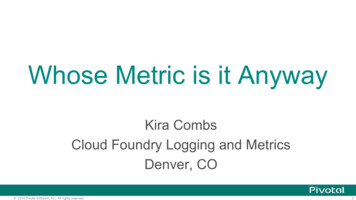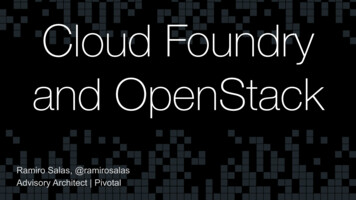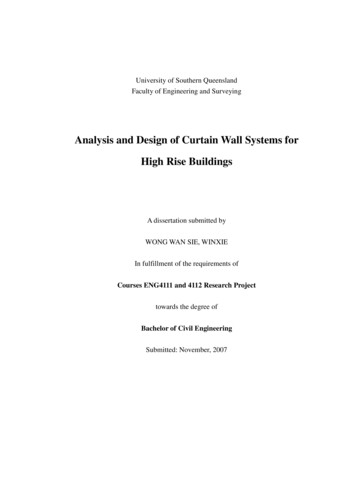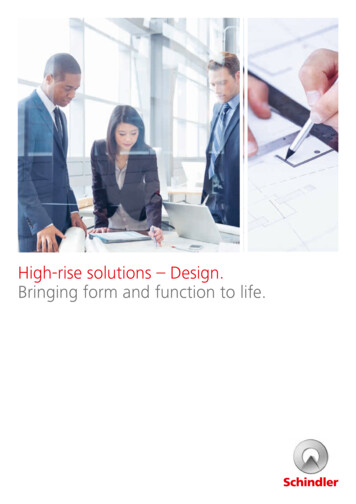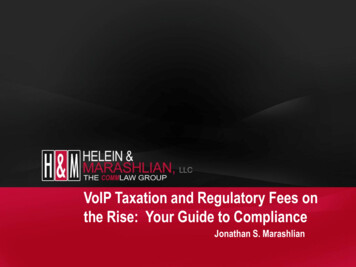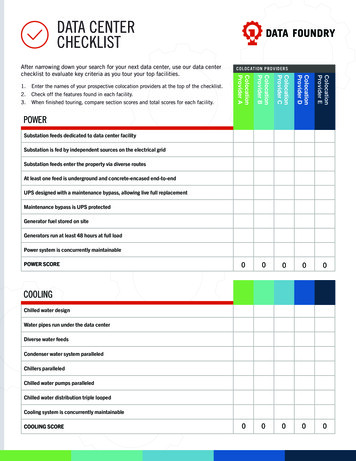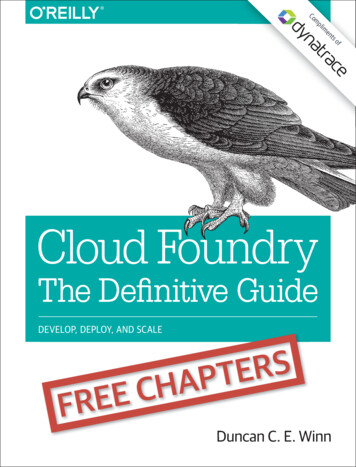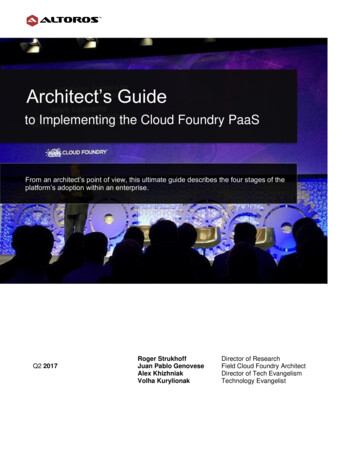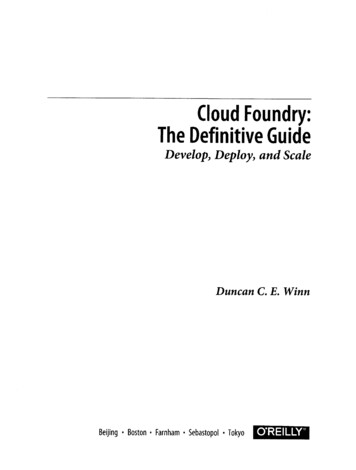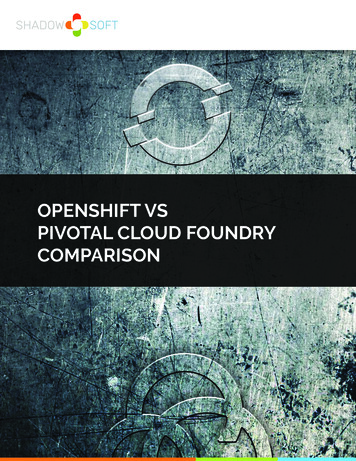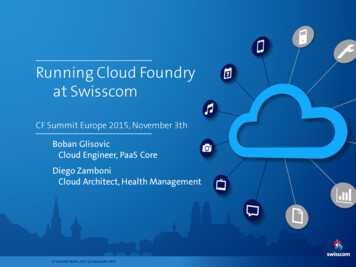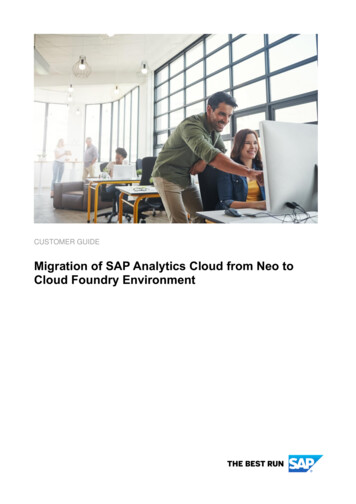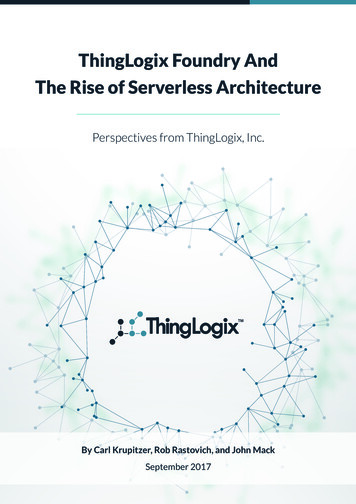
Transcription
ThingLogix Foundry AndThe Rise of Serverless ArchitecturePerspectives from ThingLogix, Inc.By Carl Krupitzer, Rob Rastovich, and John MackSeptember 2017
Understanding Serverless ComputingThe history of computing in the modern era is characterized by a repeating pattern of growth, pause, and resurgent growth.Technical breakthroughs drive early adoption, which gathers momentum that fuels an initial wave of mass adoption andhyperscale growth. As the newly adopted technologies become more mature, breakthrough innovation yields to incrementalrefinements, causing technical capabilities to evolve more slowly and economic growth to moderate. Eventually, another technicalbreakthrough emerges, either as a more efficient version of a prior technology or as an entirely new technological approach to thechallenge at hand. Within the realm of computing, we are witnessing the early stages of an important phase in the evolution of cloudcomputing – the emergence of serverless computing.The history of cloud computing is well known among technologists and technology investors. Single-location models yielded tolocally distributed models, locally distributed models evolved into large-scale distributed models, and as this occurred, ownershipof the underlying infrastructure – network, compute, and storage – no longer implied that the owner of the data was necessarilythe owner of the infrastructure. Cloud computing, broadly encompassing SaaS, PaaS, and IaaS, initially bifurcated into private andpublic cloud models. It has since evolved into complex hybrid models that allow organizations the flexibility to dynamically manageworkloads in a manner that conforms to specific preferences regarding performance, security, compliance, avoidance of vendorconcentration, or other factors.Serverless computing and the related concept of Function-as-a-Service (FaaS) represent an important extension of the cloudcomputing model, insofar as they significantly enhance the technical capabilities of systems and business processes that rely uponthem, create market conditions for dramatically accelerated business adoption of cloud technologies, and enable new businessmodels, higher velocity of innovation, and stronger business results.What are serverless computing and FaaS? Three definitions can help frame the conversation.Per Wikipedia:Serverless computing is a cloud computing execution model in which the cloud provider dynamically manages the allocation of machineresources. Pricing is based on the actual amount of resources consumed by an application, rather than on pre-purchased units of capacity. Itis a form of utility computing.http://en.wikipedia.org/wiki/Serverless computingServerless computing still requires servers. The name "serverless computing" is used because the server management and capacity planningdecisions are completely hidden from the developer or operator. Serverless code can be used in conjunction with code deployed in traditionalstyles, such as microservices. Alternatively, applications can be written to be purely serverless and use no provisioned services at all.Per Gartner:Serverless computing uses cloud attributes natively to execute user-defined functions, giving the consumer limited control over rtner.com/doc/3444017infrastructure. Serverlesscomputing solutions execute logicin environments with no visible VM or OS.http://www.gartner.com/doc/3587220Per Stackify:FaaS is the concept of serverless computing via serverless architectures. Software developers can leverage this to deploy an individual "function", action, or piece of business logic. They are expected to start within milliseconds and process individual requests and then the /4081479Principles of FaaS:- Complete abstraction of servers away from the developer- Billing based on consumption and executions, not server instance sizes- Services that are event-driven and instantaneously scalableThingLogix has embraced both the solution architecture principles and the business value proposition of serverless computing andincorporated them into our cloud-based platform and products for smart, connected solutions.www.thinglogix.com1
ThingLogix: Optimizing IoT Solutionsin The Serverless IT EnvironmentThingLogix offers Internet of Things (IoT) solutions, solution components, and services based on serverless architectures.Our market model is best described as “Product-led, Platform-enabled, Services-supported.”Our offerings include:THE PRODUCT: Foundry PackagesSets of composite IoT functionality packaged to enable specific use cases.THE PLATFORM: FoundryA cloud-based solution development and management platform (PaaS) that offers critical core functionality for managing theentire lifecycle of IoT solutions.THE SERVICES- Development services: development of IoT solutions based on Foundry, Foundry Packages, and AWS serverlessinfrastructure and services- Advisory services: helping companies optimize both the business and technology dimensions of IoT solutionsMarket-facingIoT SolutionsFoundryPackagesConnected Vehicle SystemsConsumer ProductsSmart BuildingsOther IoT SolutionsUSE CASESIndustriesBusiness FunctionsIntegrationsFUNCTIONAL AssetManagementDevelopment &Debugging orageOur technology enables sophisticated functionality, rapid time-to-market, simplified solution evolution over time, and extreme costefficiency. Foundry Packages enable market-facing IoT solutions for specific industries and use cases, supporting specialization,differentiation, and competitive advantage. Foundry optimizes the development, deployment, and operation of market-facing IoTsolutions architected on Amazon Web Services (AWS).Our development services take a full-lifecycle approach, from business planning, to design and build, to testing and refining, todeploying and integrating, and on to operating, maintaining, and evolving the solution over time. For our development servicesclients, we architect IoT solutions on Foundry, which simplifies our clients’ ability to manage and evolve their solutions over time.By abstracting the complexity of the underlying cloud architecture and simplifying solution management workflows, Foundry letsdevelopers and product teams focus on running their business, not on writing and rewriting code over the life of the solution.www.thinglogix.com2
With a history of success developing, implementing, and managing IoT strategies and solutions in a wide variety of complex enterprise settings, we believe that we offer our solution customers and professional services clients a level of credibility that is distinctin the market.From its inception, ThingLogix developed Foundry as a serverless PaaS with a focus on IoT. We have architected Foundry to alignwith the enterprise’s increasing shift to serverless computing by embracing the concept of reusable mini- and microservices.According to industry analyst Gartner, “Miniservices and microservices are highly complementary service models. Monolithicapplications are refactored into shared, reusable miniservices that reduce the scope of a service down to an individual capability.Miniservices are designed to support composition and reuse. These services publish APIs that can be accessed from client apps andfrom other services, and they enable integration and interoperability across application systems.”Foundry alleviates the underlying architectural complexity associated with serverless by implementing a flexible framework thatallows developers to use configuration instead of custom code to quickly develop business processes on top of the core microservices needed to orchestrate underlying compute resources. This dramatically improves application development cycle time, as wellas time associated with maintaining and evolving fielded applications over time as the underlying cloud infrastructure-levelservices change. It also renders the question “where do I even put my code” completely obsolete. Additionally, the flexible framework upon which Foundry is based allows them to easily package Foundry application functionality for distribution. This helpsbusinesses strengthen their ability to create a robust ecosystem of developers, offer highly specialized vertical applications and,enable a marketplace for pay-per-use microservices.www.thinglogix.com3
Foundry Is An Event-driven Application PlatformDigital transformation is a term that broadly describes the integration of digital technologies into business models,processes, and market offerings in such a way that a company conducts business operations in a radically different, moreagile, and more efficient manner. As more companies embrace digital transformation, they will encounter a key aspect of this waveof change: the shift from data-centric drivers of decisions and actions to event-centric drivers. This means that the simple occurrence of predefined events will increasingly drive business models, direct business processes, and power both physical andsoftware-centric market offerings. ThingLogix believes that this shift to a central role for event processing in digital business willdrive broader adoption of serverless computing. This, in turn, will benefit serverless-centric PaaS providers and companies usingcloud platforms architected on serverless principles.In the past, enterprise platforms have often struggled to gain widespread adoption. Reasons for these challenges vary widely, andinclude such issues as:- Perceptions that the platform represented a non-essential middleware layer in the technology stack- Platforms’ often narrow focus on a specific use case (e.g., sales, mobile, a specific developer language)- Customer aversion to relying too heavily on a specific vendor (i.e. concern about “vendor lock-in”)- An implicit requirement that the customer would need to adopt a fundamentally different, and often unproven,technology approach- A preference to wait for market validation before adopting (i.e. assessing whether the platform has emerged as a viableindustry standard vs. remaining an obscure alternative, failing to gain adoption, and lapsing into obscurity)The Internet of Things – a network of devices and systems operating in synchronicity to achieve purposeful, coordinated outcomes– is a concept that has increasingly become a reality, and that stands to significantly accelerate companies’ evolution from data-centric to event-driven businesses. When internetworked devices communicate with each other and with other systems, the devicescan take action to effect change in the environment in which the device operates. Devices essentially become intelligent sensorsand actuators, with the ability to take action autonomously or after prompting the regulating system for permission to act andreceiving such permission. The “currency” that flows through such an internetworked system is events. The system designerdefines how a given device should react in response to specific types of events, and when such events occur, they serve as thecatalyst to trigger whatever actions the device has been programmed to take.Event-driven solution architectures have profound implications for how businesses gather information, make decisions, takeactions, and compete in the marketplace. Industry analyst Gartner has described how IT architectures will undergo a fundamentalshift from data-centric ecosystems to event-centric ecosystems. (see accompanying diagram)DATA STORE-DRIVEN: THE OLD WAYAppEVENT-DRIVEN: THE NEW WAYAppDataEventEventServiceDataServiceThe source of truth is the data store.First priority: Preserve dataThe source of truth is the log of events.First priority: React to eventsSOURCE: GARTNER (OCTOBER 2016)www.thinglogix.com4
Data-centric models rely on the collection of data in a data store, which ingests event information, informs applications, and directsactions to occur in the form of services. Event-based architectures place events at the center of the architecture, such that theevent itself is the information that triggers actions (services), informs applications, and flows to the data store. The event-basedarchitecture accelerates the cycle time of workflows by predefining actions that reduce or obviate the need for data analysis inresponse to an event. Event-based architectures also complement machine learning and artificial intelligence technologies, insofaras these technologies allow systems to learn from a series of events, identify patterns, formulate decisions, and either recommendaction or take action autonomously.The digital technology platform underlies an organization’s approach to managing business models, processes, and market offerings. As such, it is important to consider the aforementioned shift through the lens of the platform.There are five major types of digital technology platform in the enterprise:--Information system platforms — Support “back office” operations such as ERP and other core systems, as well asassociated middleware and development capabilities that deliver solutions.Customer experience platforms — Contain the principal customer-facing functionality, such as customer and citizenportals, multichannel commerce, and customer applications.Analytics and intelligence platforms — Provide information management and analytical functionality. Includes datamanagement programs and analytical applications that enable data-driven decision making, as well as algorithms thatautomate discovery and action.Business ecosystem platforms — Support the creation of, and connection to, external ecosystems, marketplaces andcommunities. The main elements are API management, control, and security.IoT platforms – Collections of technologies and standards that form a base set of capabilities for communicating with,controlling, managing, and securing elements of internetworked devices and syste
The Rise of Serverless Architecture Perspectives from ThingLogix, Inc. By Carl Krupitzer, Rob Rastovich, and John Mack September 2017. he history of computing in the modern era is characterized by a repeating pattern of growth, pause, and resurgent growth. Technical breakthroughs drive early adoption, which gathers momentum that fuels an initial wave of mass adoption and hyperscale growth.
